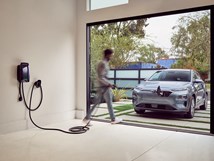Tesla Readies Faster Charging Stations
Tesla Inc. says it can cut charging times for its electric vehicles by 50% with higher-capacity charging stations and battery pre-heating.
#hybrid
Tesla Inc. says it can cut charging times for its electric vehicles by 50% with a higher-capacity charging stations battery pre-heating.
The carmaker unveiled the first V3 Supercharger station this week near the company’s auto plant in Freemont, Calif. Additional facilities will be added in North America over the next six months, then introduced in Europe and Asia by year-end.
Equipped with a 1-mW central “power cabinet,” the third-generation charging stations will support peak charging rates of 250-kW per vehicle—compared with 120-kW for V2 Supercharger units. In addition, customers will be able to charge their vehicles at full capacity without having to share power with vehicles using other charging ports.
The V3 Superchargers use a new liquid-cooled cable that Tesla says is “significantly” lighter, more flexible and more efficient than current air-cooled cables.
Tesla also is rolling out a new feature this week that will allow customers to heat their car’s battery to an optimal temperature as they drive to any Supercharger station. The carmaker says this will reduce average charge times by 25% at a V2 station. Using the battery warmup system at a V3 station will reduce average charge times by about 50% compared with current V2 stations, according to Tesla.
The beta V3 station in California initially will be available only to select owners of Tesla’s Model 3 sedan. Long-range versions of the Model 3 will be able to replenish as much as 75 miles of driving capacity within five minutes at the V3 stations, according to the company. Average charge times at the station are expected to drop to 15 minutes.
In coming months, Tesla intends to provide over-the-air software updates to owners of its Model S and Model X vehicles, so those models can access V3 Superchargers too. The company also is upgrading V2 stations to increase charge rates from 120 kW to 145 kW.
RELATED CONTENT
-
How to Build a Military Vehicle from a Pickup Truck
A real piece of military gear. A real pickup that you can get at a Chevy dealership. A really remarkable story.
-
Aluminum Sheet for EV Battery Enclosure
As the number of electric vehicles (EVs) is about to increase almost exponentially, aluminum supplier Novelis is preparing to provide customers with protective solutions
-
On Fuel Cells, Battery Enclosures, and Lucid Air
A skateboard for fuel cells, building a better battery enclosure, what ADAS does, a big engine for boats, the curious case of lean production, what drivers think, and why Lucid is remarkable








